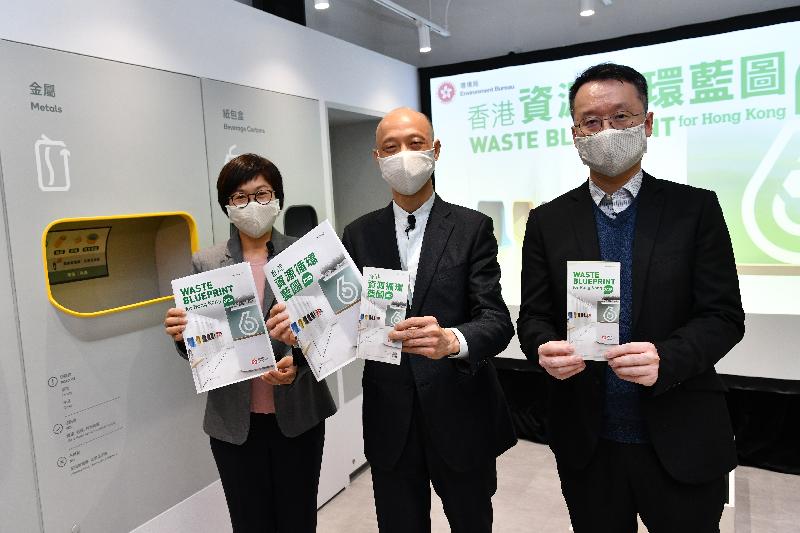Government announces Waste Blueprint for Hong Kong 2035 (with photo)

***********************************************************
In May 2013, the Government unveiled Hong Kong: Blueprint for Sustainable Use of Resources 2013-2022 to achieve the goal of "Use Less, Waste Less" through various initiatives in three main aspects, namely policies and legislation, social mobilisation and investing in infrastructure. Except for the municipal solid waste (MSW) charging bill being examined by the Legislative Council, other key actions have been carried out with good progress. Additional initiatives have also been introduced.
Announcing the updated version of the blueprint today, the Secretary for the Environment, Mr Wong Kam-sing, said, "The Chief Executive announced in her 2020 Policy Address that a long-term strategy blueprint on waste management would be launched. Building on the blueprint released in 2013 and the momentum of previous efforts in waste reduction and recycling, we have formulated a long-term waste management strategy that can keep abreast of the latest situation. Facing the challenges of a downturn in the external recycling market, the current high level of waste disposal, and the scarcity of our land resources, we have to make greater efforts in mobilising the entire community to practise waste reduction and implement measures for achieving waste reduction and recycling on a considerably larger scale, thereby promoting transformation of waste into resources. This helps build a circular economy, create job opportunities, and achieve decarbonisation to combat climate change. In the long run, we also need to formulate strategies to progressively move away from over-reliance on landfills."
The new blueprint advocates "Waste Reduction‧Resources Circulation‧Zero Landfill". Under this vision, the Government will work with the industry and the community to move towards two main goals. The medium-term goal is to gradually reduce the per capita MSW disposal rate by 40 to 45 per cent and raise the recovery rate to about 55 per cent by implementing MSW charging, while the long-term goal is to move away from the reliance on landfills for direct waste disposal by developing adequate waste-to-energy facilities. To achieve the above goals, the Government will promote six major areas of action, namely Waste Reduction, Waste Separation, Resources Circulation, Industry Support, Innovation and Cooperation, and Education and Publicity, leading the advancement of various policies and measures as well as building a circular economy and a sustainable green living environment.
Mr Wong expressed gratitude to various stakeholders for providing their valuable opinions to the Environment Bureau (ENB) on the development of the long-term strategy blueprint. The Government will assume a more proactive role, such as further promoting various policies and legislation, in particular the MSW charging initiative that would serve at the forefront of effectively promoting waste reduction and recycling. The ENB will also consult members of the public on the implementation of the producer responsibility scheme for plastic beverage containers and the recommendations for the control of disposable plastic tableware in phases. It will also consider the need to handle other single-use plastics.
The Environmental Protection Department (EPD) has been extending the community recycling network in 18 districts, with a view to strengthening the central collection services of recyclables, further encouraging waste reduction and recycling by the general public, and nurturing green living habits in the community. The Recycling Stations, Recycling Stores and Recycling Spots in the districts are progressively commencing services, forming a new community recycling network and bringing a new clean recycling experience to the public. In addition, the ENB will reinforce support for the recycling sector so as to enhance the effectiveness of transforming waste into resources and establish a circular economy. It will also expand the local waste-to-resources/energy capacities by setting up the required infrastructure in a timely manner to handle waste in a more sustainable and low-carbon manner in order to achieve the long-term goal of "Zero Landfill".
The Waste Blueprint for Hong Kong 2035 is available on the Environment and Ecology Bureau website (www.eeb.gov.hk/sites/default/files/pdf/waste_blueprint_2035_eng.pdf).
Ends/Monday, February 8, 2021
Issued at HKT 17:00
Issued at HKT 17:00
NNNN


